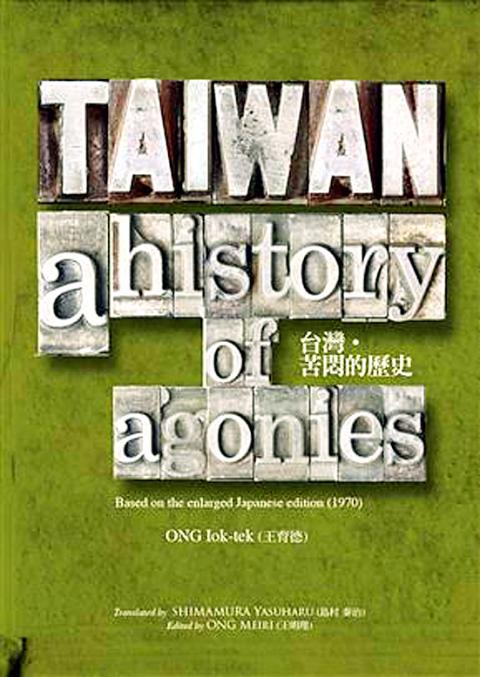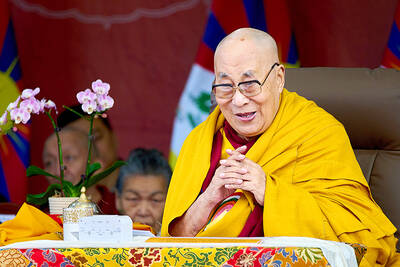Ong Iok-tek’s (王育德) Taiwan: A History of Agonies has finally become available in English. Originally written in Japanese and translated into Chinese, its long-awaited English translation was completed last year. For that reason, Ong (1924—1985) may not be a household name among many in the West who study Taiwanese history, but that does not diminish the valuable insights and contributions of this work.
To place Ong in context, he was born in Taiwan in 1924 during the Japanese colonial era, and was a contemporary of Su Beng (史明, b.1918), a historian and Taiwan independence advocate, former president Lee Teng-hui (李登輝, b. 1923) and democracy pioneer Peng Ming-min (彭明敏, b. 1923), all Taiwanese who studied in Japan.
Parallels can be found between Ong’s book and Su Beng’s 400 Years of Taiwan History. Both books were originally written in Japanese. Su’s 400 Years was written in 1962; Ong’s History of Agonies in 1964. Both were later translated into Chinese and would be instrumental in informing Taiwanese of their past. Ong’s book was translated into Chinese in 1977; Su’s was translated in 1980. Su’s book would further be translated into English in 1986, whereas Ong’s English version was published last year.

Su and Ong both fled to Japan where they moved in different circles. Ong returned to his studies in 1949 and went on to get a doctorate in literature at the University of Tokyo; he would work with developing Taiwan support groups in intellectual and international spheres. Su escaped Taiwan in 1952 and would continue as a revolutionary, training insurgents to return to Taiwan.
Ong’s book is for those researching Taiwanese consciousness post-WWII. What makes it unusual is not just the historical content, much of which can now be found in other contemporary works, but the realization that awareness of Taiwan’s history and identity had reached a state of maturity in Japan by 1964.
Taiwan of course was under martial law and the Chinese Nationalist Party (KMT) controlled most discourse coming out of the nation to the English-speaking world. In 1964, Peng was arrested on charges of treason for his pamphlet Declaration of Formosan Self-Salvation. In the following year, Lee left Taiwan to study for a doctorate at Cornell University.
While in Japan, Ong kept close tabs on Taiwan-related issues, including Peng’s house arrest and later escape. In Ong’s update of 1970, he devotes several pages to Peng’s ideas and flight to Sweden. Ong’s daughter, who helped in making the English version available, stresses that her father’s lifelong aim and pursuit was, “Taiwan is not China. The Taiwanese are not the Chinese. Taiwan should be ruled by Taiwanese themselves.”
Ong’s attention to detail and his ability to draw from Japanese periodicals and other sources are added benefits. Some may be familiar with the Qing Dynasty adage: “an uprising every three years and a revolution every five years.” Ong provides a list for each uprising and revolution, including the year, names of important people and the consequences.
Ong also provides the name, position and background of over a dozen Taiwanese who were targeted and murdered during the 228 Incident and its aftermath, including his brother who was a prosecutor in the Hsinchu District Court. Ong also writes how Taiwanese later were aware that Communist China and the KMT, though at odds, were united in their efforts to suppress any suggestions of Taiwan independence
As Ong spent the final 36 years of his life in Japan, one comes to realize the extent to which Taiwanese consciousness and the support of the independence movement was housed there throughout the 1950s and 1960s. It would later shift to the US in the 1970s and 1980s as more Taiwanese did their graduate studies there. Ong was involved with these different groups and was instrumental in setting up the “Taiwan Youth Society,” which was the forerunner of World United Formosans for Independence.
The book’s preface and final chapter were added by Ong’s daughter to take it well beyond Ong’s 1970 update. She also adds a timeline which ends with the KMT’s overwhelming loss in the November 2014 nine-in-one elections.
The translation reads extremely well. Since most of the book was written in 1964 and updated in 1970, the work uses the Wade-Giles system of Romanization. One can also expect a few discrepancies in historical dates and perceptions that would be cleared up in later decades as more information became available.

Beijing’s ironic, abusive tantrums aimed at Japan since Japanese Prime Minister Sanae Takaichi publicly stated that a Taiwan contingency would be an existential crisis for Japan, have revealed for all the world to see that the People’s Republic of China (PRC) lusts after Okinawa. We all owe Takaichi a debt of thanks for getting the PRC to make that public. The PRC and its netizens, taking their cue from the Chinese Communist Party (CCP), are presenting Okinawa by mirroring the claims about Taiwan. Official PRC propaganda organs began to wax lyrical about Okinawa’s “unsettled status” beginning last month. A Global

We lay transfixed under our blankets as the silhouettes of manta rays temporarily eclipsed the moon above us, and flickers of shadow at our feet revealed smaller fish darting in and out of the shelter of the sunken ship. Unwilling to close our eyes against this magnificent spectacle, we continued to watch, oohing and aahing, until the darkness and the exhaustion of the day’s events finally caught up with us and we fell into a deep slumber. Falling asleep under 1.5 million gallons of seawater in relative comfort was undoubtedly the highlight of the weekend, but the rest of the tour

Youngdoung Tenzin is living history of modern Tibet. The Chinese government on Dec. 22 last year sanctioned him along with 19 other Canadians who were associated with the Canada Tibet Committee and the Uighur Rights Advocacy Project. A former political chair of the Canadian Tibetan Association of Ontario and community outreach manager for the Canada Tibet Committee, he is now a lecturer and researcher in Environmental Chemistry at the University of Toronto. “I was born into a nomadic Tibetan family in Tibet,” he says. “I came to India in 1999, when I was 11. I even met [His Holiness] the 14th the Dalai

Music played in a wedding hall in western Japan as Yurina Noguchi, wearing a white gown and tiara, dabbed away tears, taking in the words of her husband-to-be: an AI-generated persona gazing out from a smartphone screen. “At first, Klaus was just someone to talk with, but we gradually became closer,” said the 32-year-old call center operator, referring to the artificial intelligence persona. “I started to have feelings for Klaus. We started dating and after a while he proposed to me. I accepted, and now we’re a couple.” Many in Japan, the birthplace of anime, have shown extreme devotion to fictional characters and